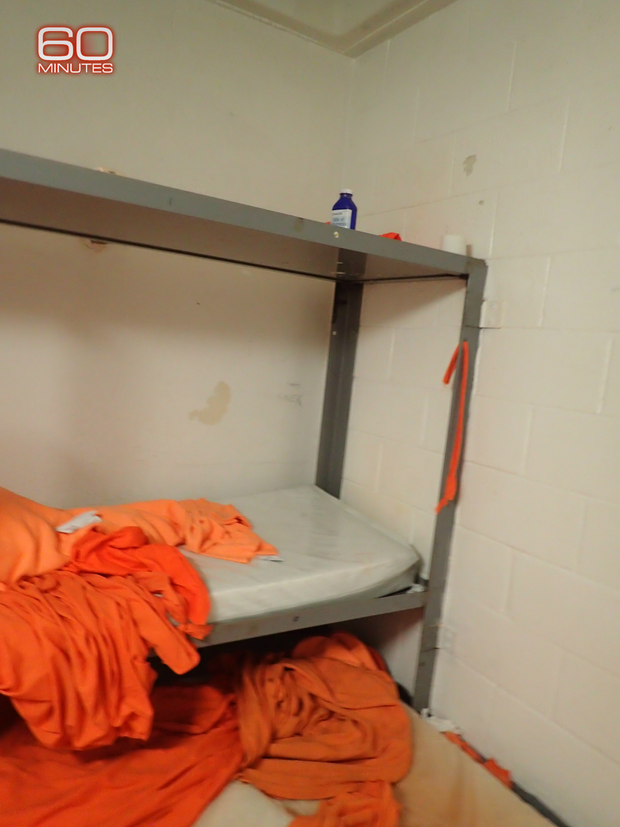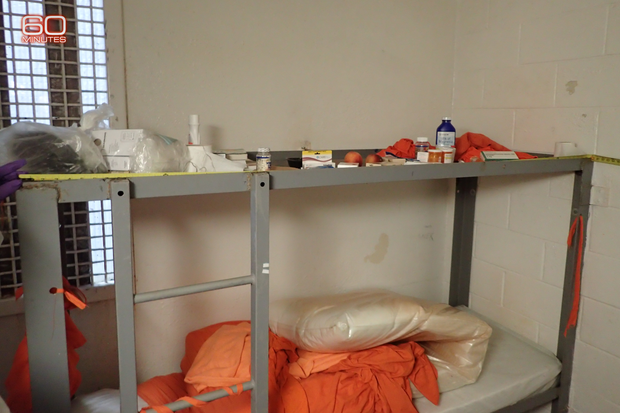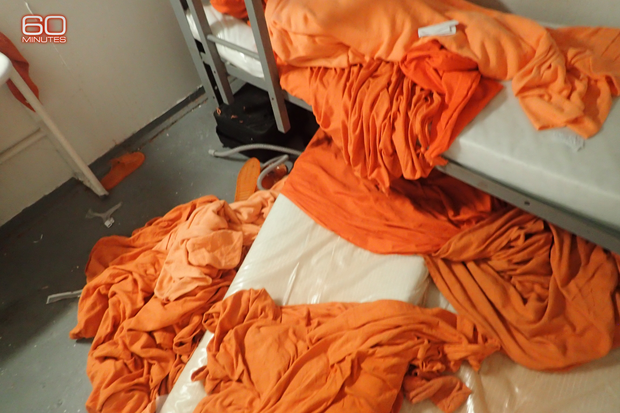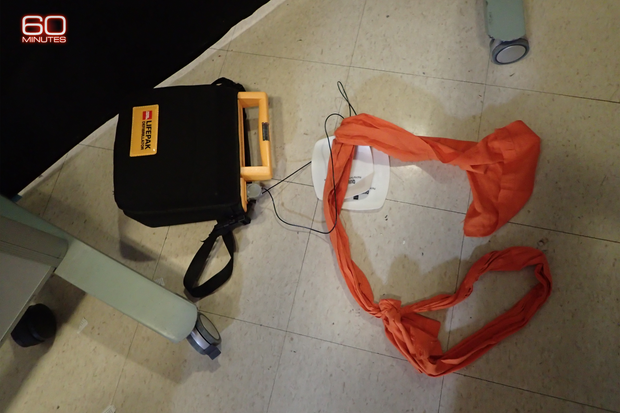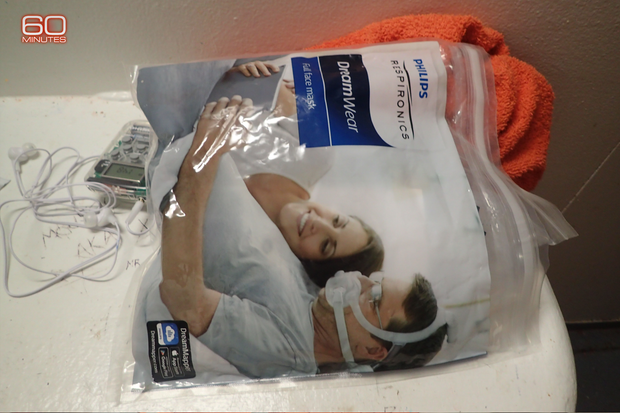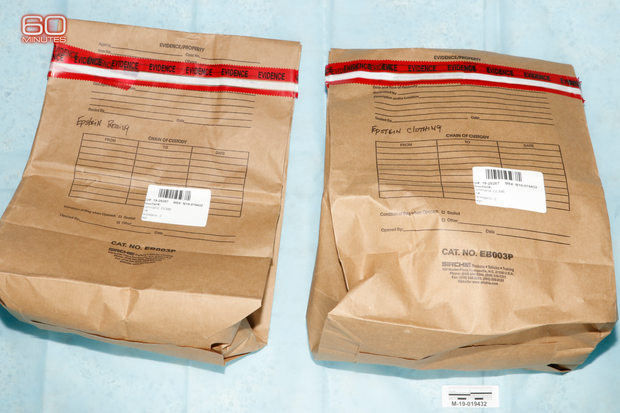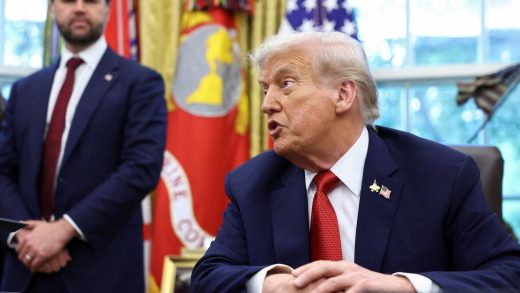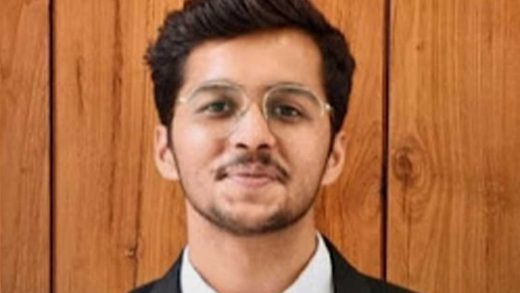The federal investigation into the death of convicted sex-trafficker Jeffrey Epstein was marred by significant lapses, experts told CBS News, including the failure by investigators to interview potential witnesses, properly preserve certain evidence and run basic forensic tests.
Nearly two years passed before investigators interviewed the two key corrections officers on duty the night Epstein died in his cell in the Metropolitan Correctional Center in downtown New York City, in what was later ruled a suicide, according to court documents. One of those officers was the only person to attest to seeing Epstein hanging by a bedsheet from his bunk.
And details pulled from 90 photos of the cell and other evidence collected in the hours after Epstein’s death — but before FBI agents arrived to process the scene — appear to show a succession of basic oversights, ranging from an absence of evidence markers to items being moved, experts told CBS News.
60 Minutes
“The FBI literally has all of the best tools. I mean, spared no expense. They have every tool you can imagine. And they used none of it as far as we can tell,” forensic analyst Nick Barreiro said after reviewing the photos, many of which have never been published. “How are there not way more people pointing out the absurdity of this?”
The images were previously obtained by 60 Minutes. After the recent release of surveillance video from the night Epstein died, which appeared to show details that contradicted official reports, CBS News reviewed them and other documents with several forensic experts.
The results of the federal investigation were made public in 2023, four years after Epstein’s death, in a report by the Department of Justice Office of Inspector General. It concluded that the financier, who entered a guilty plea in 2008 on state-level charges of procuring a child for prostitution, died by suicide. That matched the findings shared by Attorney General William Barr, who told Congress in August he had no doubts that Epstein had taken his own life. But lingering questions, raised by individuals including Epstein’s lawyers and brother, have fueled continued speculation and suspicion.
“I do not believe he died by suicide, no,” Epstein’s co-defendant, Ghislaine Maxwell, said this summer during her interview in August with the Deputy U.S. Attorney General Todd Blanche.
Epstein’s brother, Mark, told “60 Minutes” in 2020 that, in his view, the evidence he has seen to date points more to murder than suicide. Five years later, he still questions the investigation.
“This was never properly investigated as a proper homicide, it was never investigated,” Mark Epstein told CBS News recently.
Nothing about the CBS News review into the investigation of Epstein’s death suggests foul play. But the review found that the federal probe did not follow typical investigative procedures into a suspicious death.
“Evidence photography 101”
Epstein’s body was discovered at 6:30 a.m. on Aug. 10, 2019 by corrections officer Michael Thomas when he arrived at his cell to deliver breakfast. Thomas said he found the accused felon in a near-seated position, suspended from the top of the bunk by a homemade noose, with his legs straight out and his buttocks approximately 1 inch to 1 and a half inches off the floor, according to the inspector general’s report. Internal corrections department memos obtained exclusively by CBS News described him as “cold,” with “no palpable pulses.”
The first FBI agents arrived at the cell more than seven hours later, at 1:35 p.m., according to the 2023 report. But when they arrived, photos show they found a disorganized, rifled-through clutter. Crucially, Epstein’s lifeless body had already been removed from the cell, eliminating a critical source of information investigators would need to determine how and when he died, forensic pathologist Michael Baden said.
“The fact that he was moved diminishes the ability to determine how long he was dead before he was found,” Baden said.
Emergency medical technicians wrote in their report on the incident, which was obtained by CBS News, that the staff they interacted with could not say when Epstein was last seen alive or describe how he “was found in [the] jail cell other than to say ‘we found him on the ground.'”
Inside the cell, piles of linens had been strewn about, mattresses were squeezed into a corner on the floor near his bunk bed and Epstein’s personal items were rearranged or moved, photos from the scene show. Experts who reviewed photos of the scene for CBS News said there were also inconsistencies between the investigators’ official reports and what the images show.
60 Minutes
“In those photographs, it was obvious that things were moved around,” said former New York Police Department detective Herman Weisberg, who is now managing director of Sage Intelligence. “It definitely appeared to me that the scene was, for lack of a better term, staged a bit.”
Epstein’s medications, a special mask for treating sleep apnea, and at least one piece of fabric tied into a noose appeared in different places over the course of 90 minutes, when a photographer from the medical examiner’s office was documenting the scene.
Weisberg and other experts emphasized that, regardless of whether Epstein’s death was a suicide, the cell should have been treated as a crime scene using standard investigatory practices.
“It almost appears to me that whoever was investigating this just took it at face value that it was a suicide with no foul play whatsoever, suspected,” Weisberg said. “But in a situation as high-profile as this, I would always, as an investigator, consider that there might be foul play.”
While some experts questioned federal investigators’ treatment of the scene, forensic pathologist Judy Melinek, who used to work at the New York City Medical Examiner’s office, said her former employer appears to have handled the case by the book.
“It’s just people doing what they normally do for any other case,” Melinek said. “The majority of [cases] if you weren’t such a high profile decedent, the scrutiny would not apply. This is how they treat every other jail death of somebody who is not high profile.”
The sequence of evidence photos starts with a picture of the stairs leading up to Epstein’s cellblock, Tier L. Underlying data from the photo shows it was taken at 9:34 a.m. — three hours after Epstein’s body was found, and four hours before federal investigators arrived.
Time went by even as the nation’s top law enforcement officer sought a rapid investigation.
“I was obviously covering it very quickly and wanted to rule out anything other than suicide,” Barr told Congress in August, adding that “within an hour, or minutes of finding out about it, I directed the [inspector general] to have people in New York go to the scene and conduct an investigation.”
On the back wall, a surveillance camera is visible. It was streaming, but was not recording. This was due to a hard-drive malfunction that had previously been identified but not fixed, according to a Justice Department report.
Next is a blurry image of the door to Epstein’s cell, number 220. Running underneath the door was a cable that provided power to a CPAP machine. Epstein had initially been assigned to a cell in a different tier, but he was moved to cell 220 for easier access to an outlet, according to Bureau of Prisons records.
The jail’s computer systems were never updated to note that move, according to investigators. A source close to the investigation told CBS News that corrections staff rarely updated internal inmate moves, instead preferring to call out their names while in the tiers.
Two documents on the door are shown in images after Epstein’s death. One was a printout with Epstein’s personal details and a booking photo. Above that was the ID card for Epstein’s former roommate, Efrain Reyes.
Cells typically hold two inmates, and following a suspected suicide attempt two weeks earlier, Epstein was mandated by correction officials to have a cellmate. The day before Epstein’s death, however, Reyes was transferred out of the detention center. Investigators eventually concluded that Reyes’ move allowed Epstein the solitude needed to kill himself.
From the first photo to the last, it is clear the scene in the cell was chaotic — so much so that investigators never conclusively determined which strip of bedsheet was around Epstein’s neck when he died.
60 Minutes
Photos of the bed also raise questions. One shows an orange string hanging from a bar. This picture was included in a 2023 report by the Department of Justice’s Inspector General, alongside a description of how Epstein was found, suggesting investigators believed that was what he had used to hang himself.
If that was the case, and the room hadn’t been disturbed before the photographer arrived, Epstein’s rear would have come to rest on a mattress, instead of hovering over the floor — complicating investigators’ explanation of how he hanged himself.
Some of the evidence was not photographed in Epstein’s cell, but instead appeared to be in an entirely different room — one with floor tiles distinct from the bare concrete of Epstein’s cell. These pictures show a defibrillator and another strip of orange cloth tied into a noose-like shape. It is visibly different from the one shown hanging from Epstein’s bed frame.
60 Minutes
There is no indication in official reports where this noose was found, or which of several knotted strips of bed linen may have been removed from around Epstein’s neck. A rendering of this noose was included in Epstein’s official autopsy. But the Justice Department later revealed in its 2023 report that “the noose depicted is not the ligature Epstein used to kill himself.”
By the time FBI agents arrived, it was clear their work would be scrutinized by the top brass inside the Justice Department.
“After the suicide, I told the headquarters to make sure that they flooded the zone,” Barr told Congress in an August deposition.
There is no indication in any official report that an FBI crime scene investigators, officially known as an Evidence Response Team, ever ran fingerprints or DNA tests on anything found in the cell.
Epstein’s autopsy report indicates medical examiners collected fingernail clippings, and swabs from his neck and hands. Epstein’s brother Mark told CBS News that he still hasn’t received any information about the results of DNA tests, if they were carried out, and Barr said in his deposition that he couldn’t remember if they had been done.
A 2024 report by Department of Justice researchers warned that investigators risk missing an important “opportunity” to gather evidence “if DNA is not collected at the scene as needed or at the time of examination.” They advised that “body swabs should be considered both at the scene and during autopsy.”
Weisberg said investigators left too many stones unturned, missing the opportunity to close the case in a way that would feel conclusive to the public.
“In the back of any good investigator’s mind, he’s preparing this to be scrutinized by counsel. In this case, you’re preparing it to be scrutinized by a lot of desktop detectives … so you better have all of your facts straight,” Weisberg said.
The FBI “inspected the cell and retrieved what [they] believed to be relevant to its investigation into the cause of Epstein’s death, which included one torn sheet, miscellaneous papers, and an MP3 player,” inspector general investigators wrote in the 2023 report.
60 Minutes
Forensic analyst Barreiro said he considered the agency’s treatment of the scene to be striking.
“Some really shoddy work here, if you can even call it that,” Barreiro said. “I mean there’s an absence of work here.”
One basic procedure, which Barreiro referred to as “evidence photography 101,” is photographing scenes in a progression that goes from a wide shot to close-ups, with markers identifying evidence.
“There’s no evidence markers in any of these photographs. Like, how do you keep track once you get the stuff back to the crime lab? This is essentially useless,” said Barreiro, a former police detective and an FBI-trained member of the Digital Imaging and Video Recovery Team.
Interviews
Federal investigators questioned 54 people before issuing their final report, including three inmates who had been housed on Epstein’s tier, as well as jail staff, administrators, contractors and his brother. However, several other witnesses or their representatives told CBS News they were not interviewed. That included many other inmates housed in Epstein’s tier the night of his death, at least one staffer who arrived at Epstein’s cell shortly after his body was found and nearly all of the visitors he saw in the days leading up to his death.
Two witnesses who did provide eyewitness accounts, with their lawyers present, were in the cell directly across from Epstein’s the night he died. One described seeing Thomas, the first corrections officer on scene, enter Epstein’s cell and begin performing CPR, only to emerge holding a rope and a defibrillator. The other said he saw Thomas enter and shake Epstein. He said Thomas tried to pick Epstein up, but fell over. He then began giving chest compressions, the inmate said.
The accounts, which appear in the official report, do not explain what is seen in photos of the jail tier — their cell windows covered by papers that could have obscured any view outside.
It’s not clear if the cell window was papered over in the time after Epstein’s death but before the first photos were snapped. The Bureau of Prisons declined to comment.
Attempts to reach Thomas were unsuccessful. A lawyer for his former coworker, Tova Noel, said she would not comment. The former officers agreed to be interviewed by investigators in 2021, as part of a deal that saw prosecutors drop charges of falsifying records related to mandatory checks on Epstein and other inmates, after falling asleep on the job.
Other staffers with first-hand knowledge of the scene and other events were never contacted by federal investigators, according to interviews with CBS News.
Investigators also decided not to interview some of Epstein’s visitors, several sources told CBS News. The inmate spent the bulk of his daylight hours with a large, rotating cast of attorneys — including on the day before his death. The younger lawyers were there not only to provide counsel , but also “to basically hold his hand” and “babysit,” according to one source. They kept Epstein company, chatting with him about life, politics, literature and any other topic that came to his mind.
“You’d think if the investigation was a priority, they’d want to take a run at the younger people who were working for him,” one source told CBS News. “Nothing.”
60 Minutes
One lawyer who visited Epstein nine days before his death was David Schoen. He said Epstein told him he was actively planning to fight the criminal charges levied against him.
“And this is why I’ve said, that in my view — I don’t have anything to base it on other than anecdotal — I don’t think he committed suicide, because he was very engaged in the idea of fighting the case,” Schoen said. “He hired me. And to kill himself nine days later wouldn’t have made a lot of sense.”
While many who were close to Epstein have publicly questioned that he died by suicide, Barr has said it was — and remains — the most logical conclusion. The alternative would’ve been too complicated, Barr said in his August deposition.
“This would’ve required coordination from probably two dozen people, maybe, within the prison. And all these people were in different groups,” Barr said. “You know, the people who were repairing the cameras, the people who, you know, were responsible for opening and closing the door, the people who were responsible for putting in a new cellmate, things like that. “
